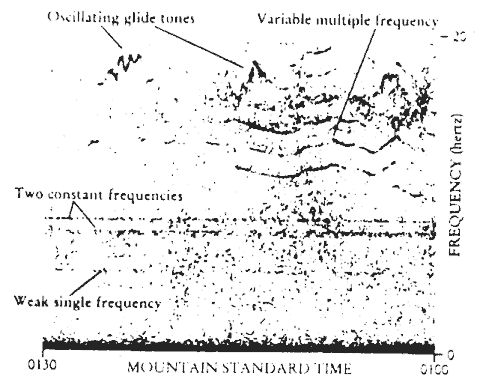 |
Science Frontiers ONLINE No. 131: SEP-OCT 2000 |
|
|
Listening for the Unhearable
sound like softly bruised silk;
They poured into the bowl of the sky
with the gentle flow of milk.
So wrote R.W. Service, the poet of the Arctic realms, about the eerie voices of the auroras. The low-frequency sound of the aurora is barely detectable by human ears. It is "felt" more than heard, as Service expressed so eloquently. Some skeptics have maintained that these ethereal sounds do not really exist, but modern instruments confirm that pressure waves are definitely produced in the atmosphere as the auroras weave and dance in the sky. Most auroral sound is in the infrasound range, which begins at the lower limit of human hearing -- about 20 Hertz. Just enough sound energy seeps over the 20-Hz limit to be heard by sensitive human ears during periods of intense activity.
Another natural infrasound, weak but continuous, is the "voice of the sea." These sound waves, called "microbaroms," have periods in the 5-7 second range (0.20-0.14 Hz), well below the range of human ears. Such low-frequency sounds travel great distances with little attenuation. It is thought, therefore, that the "voice of the sea" is an extended source -- perhaps the collective acoustical signature of all the storms from all the world's oceans. But this is surmise.
Actually, the air is full of infra-sound emanating from still-unidentified sources, as indicated in the figure.
Humans may not hear infrasound, but a form of "mountain music" seems to have a mysterious, depressing effect upon some of us.
Some infrasounds that last for as long as several days have been triangulated to distant mountain ranges and tend to occur when winds blowing over them exceed a certain speed. This effect may be a low-frequency version of the aeolian tones produced by the cyclic eddy shedding that occurs when wind flows around obstacles. The reported increase in the incidence of suicides during episodes of warm downslope mountain winds (called Chinooks in the western U.S. and the Fohn in the Alps) may be due to some as yet unknown pressure fluctuations with 20-to-70 second periods.
(Bedard, Alfred J., Jr., and Georges, Thomas M.; "Atmospheric Infrasound," Physics Today, 52:32, March 2000.)
 A sonogram of atmospheric infrasound (1-20 Hz) taken over a 30-minute period. The constant frequencies are probably due to unidentified man-made sources, but the rest of the "signals" and most of the "hash" are of unknown natural origin. |
Other Sites of Interest
|